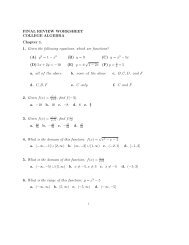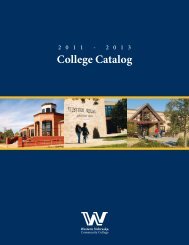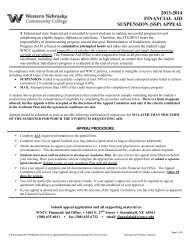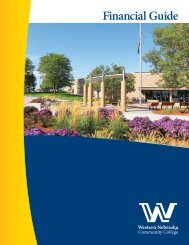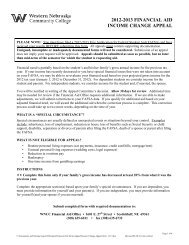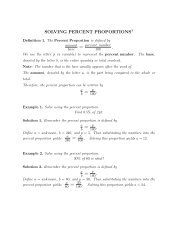WNCC 2010 Self-Study Report - Western Nebraska Community ...
WNCC 2010 Self-Study Report - Western Nebraska Community ...
WNCC 2010 Self-Study Report - Western Nebraska Community ...
Create successful ePaper yourself
Turn your PDF publications into a flip-book with our unique Google optimized e-Paper software.
In addition to the CAAP test, the College has begun to use the <strong>Community</strong> College Survey of<br />
Student Engagement (CCSSE) instrument, first administering it in during the spring term of 2007,<br />
and then using it again during the spring of 2009. CCSSE survey results from the 2007<br />
administration were reviewed with faculty and staff during in-service sessions and small group<br />
meetings. During reviews of the CCSSE report, there were discussions about changes that should<br />
be considered in accordance with the survey results. For instance, the Division of Language and<br />
Arts subsequently increased opportunities for student presentations, and mathematics instructors<br />
have incorporated strategies to increase teamwork and interaction within math courses.<br />
Results from the 2009 survey will be distributed and analyzed by faculty members and<br />
administrators. As in the past, members of the Student Learning and Assessment Committee will<br />
host discussion sessions, Division Chairs will present information to instructors, and the<br />
Educational Services leaders will hold open sessions to go over the results (RR 56).<br />
An additional benefit will accrue from the 2009 survey since administrators and instructors can now<br />
begin comparisons to look for changes in the student learning experience across the intervening<br />
time between samplings. The primary goal will remain trying to understand where and how<br />
learning occurs, the effectiveness of instruction, student perception compared to faculty perception<br />
of learning and curriculum delivery strategies, and the monitoring of learning results across time.<br />
The essential result will be the formation of improvement plans where indicated and the<br />
reinforcement of sound pedagogical practice and transference of those ideas into other<br />
instructional areas. The results of the CCSSE survey are discussed more fully in Criterion 3.<br />
As another indicator of educational effectiveness, the Career Assistance and Internship Center<br />
prepares an annual Graduate Placement <strong>Report</strong>. Statistics from the 2007-2008 Annual Graduate<br />
Placement <strong>Report</strong> presented as an example below cover students graduating at the fall, winter,<br />
and spring graduation dates.<br />
Table 6-31 Graduate Tracking <strong>Report</strong> 2007<br />
Status %<br />
Graduates Working 48.1<br />
Continuing Education 44.7<br />
Unavailable for Employment 2.1<br />
Looking for Work 3<br />
Not located 2.1<br />
(RR 57)<br />
The graduates continuing their educations at a transfer institution, as seen in Table 6-31, make up<br />
nearly one-half of the total number, while the bulk of the rest are finding employment. Just over 2%<br />
are still looking for work, a good net result for the College’s efforts.<br />
Institutional Research<br />
<strong>WNCC</strong> collects and analyzes evidence about institutional and programmatic effectiveness in a<br />
variety of ways. Institutional research is not a centralized function but is a shared responsibility<br />
between the Institutional Researcher and the Registrar. Both employees are charged with<br />
<strong>Western</strong> <strong>Nebraska</strong> <strong>Community</strong> College Page 89



